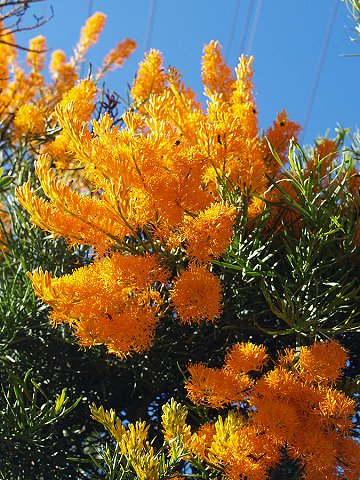
|
|
Australian Christmas tree
(Nuytsia floribunda).
|
Australian Christmas tree - Nuytsia floribunda
Nuytsia is a monotypic genus of plants, of which the species Nuytsia floribunda is a hemiparasitic tree found in Western Australia. The species is known locally as moodjar and, more recently, the Christmas tree or Australian Christmas tree, as the display of intensely bright flowers during the austral summer coincides with the Christmas season.
Nuytsia floribunda is a member of the so-called showy mistletoe family (Loranthaceae). It along with all of its mistletoe cousins reside in the order Santalales but from a phylogenetic standpoint, the family Loranthaceae is considered sister to all other mistletoes. This has excited my botanists as it allows us a chance to better understand how parasitism may have evolved in this group as a whole.
When we think of mistletoes, we generally think about those epiphytic parasites living on branches way up in the canopy. The mistletoe we are discussing in this post, however, is a decent sized tree.
‘he species is a tree up to 10 metres (33 ft) high, or as a shrub. The rough bark is grey-brown. Flowers are a vivid yellow-orange, appearing between October and January. The inflorescence on each flowering stem may be up to one metre in length.
It is a root hemiparasite, is photosynthetic and mainly obtains water and mineral nutrients from its hosts. The haustoria arising from the roots of Nuytsia attach themselves to roots of many nearby plants and draw water and therefore nutrients from them. Almost all species are susceptible to attack; haustoria have even been found attached to underground cables. In natural settings Nuytsia withdraws relatively little from each individual host, but is attached to so many other plants that the benefit to this hemiparasitic tree is likely to be considerable. Roots and rhizomes extend out and may sucker to form new branches that give the appearance of a grove of trees. A network of fine and fragile roots arise from these larger underground parts, forming haustoria where they meet the roots of other species.
It is reported that plants up to 150 metres away from N.floribunda may be parasitised.
The trunk is reported as up to 1.2 metres in diameter, with multiple layers of wood and bark that allow the tree to withstand fire. An unusual characteristic of the seedlings is the four to six cotyledons rather than two.
Recognised in early descriptions as a species of the family Loranthaceae, a group almost entirely represented by epiphytic mistletoes, allied to the order Santalales. The current treatment of Nuytsia floribunda is as a monotypic genus, Nuytsia. This species was seen as a sister taxon to Atkinsonia ligustrina (Loranthaceae) in the description Nuytsia ligustrina by Allan Cunningham in 1817, before its later arrangement to a separate genus, Atkinsonia, which also describes a single species of Loranthaceae.
The first description of Nuytsia floribunda was published by Jacques Labillardiere in his 1805 work Novae Hollandiae Plantarum Specimen, as Loranthus floribundus, the specific epithet describing the profuse flowers he would have observed at Esperance. The botanist Robert Brown published a remark on the species in 1831, giving a new genus name without a formal description. The description was published by George Don using Brown's name Nuytsia,[1] an epithet that commemorates the seventeenth-century Dutch explorer and colonial official Pieter Nuyts.
The Noongar names for the plant are moojar, moojerool, munjah and mutyal. The regional name of 'Christmas tree' has been applied since the nineteenth century. James Drummond noted in 1843 that the colonists at the Swan River referred to this species as the 'fire-tree', given for the resemblance of the inflorescence to a fire in its habitat. William Milligan reported that the first colonists used the term 'cabbage tree',[15] a reference to its fragile, white and spongey branches that can be snapped off as easily as the stalks of the European vegetable, cabbage.
The Nyungar people made use of the species during the season Kambarang, around October to early December, obtaining bark to make shields. The gum that exudes from the wound can be collected later, it is sweet and eaten raw. Moodjar (or Muja) is regarded as a protected tree by the Nyungar peoples of Southwest Australia, the species is noted as being incorporated into rituals and having a conservation status that forbids their destruction. The plant is venerated by some who learn that it should not be sat beneath or its flowers, leaves or branches touched or taken. The sugary gum is consumed in modest quantities, and children are warned of overindulgence with the story of a monstrous, invulnerable and inescapable nocturnal being who cry of 'Nhervalong' could be heard as it collects the gum on which it subsists.
According to Noongar people, when a person dies, their spirit inhabits a Christmas Tree, so its leaves should be taken inside a house or camp shelter, lest the spirit becomes trapped. The flowers; however, can be used as decoration.
Flowers are soaked in water to make a sweet drink Wood was used for shields. After taking the wood, families would return to eat the raw, sweet gum that oozed from the wounded tree.
Source:
https://en.wikipedia.org/wiki/Nuytsia
http://www.indefenseofplants.com/blog/tag/Nuytsia
http://anpsa.org.au/n-flo.html
http://www.sercul.org.au/wp-content/uploads/2017/11/
BushTuckerFactSheet_ChristmasTree.pdf
